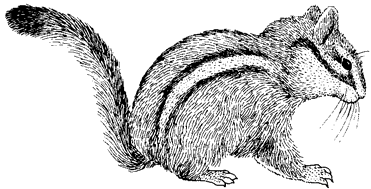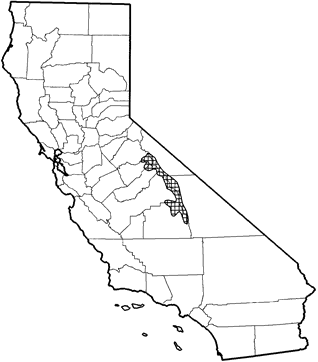
Alpine Chipmunk
Distribution, Abundance, and Seasonality
Limited to the high Sierra Nevada from the vicinity of Yosemite National Park south to Olanche Peak (Tulare Co.). The known altitudinal range is from 2280 m (7600 ft) to 3780 m (12,600 ft), but it is rarely found below 2800 m (9000 ft) (Johnson 1940). Common on cliffs, talus slopes, and fell-fields in alpine dwarf-shrub habitat.

Range Map
Specific Habitat Requirements
Feeding: Seeds of sedges, grasses, pines, forbs, and fungi eaten. Feeds on ground and among rocks and logs. Caches food for winter use.
Cover: Uses rocks and logs, subalpine trees, and talus. Uses microclimate differences between tops of rocks and spaces between rocks for thermoregulation (Heller and Gates 1971).
Reproduction: Nests in crevices between rocks.
Water: Conserves water by concentrating urine (Heller and Poulson 1972). Probably does not require source of water other than food, but will use such sources if available.
Pattern: Uses talus, rocks, and krummholz for cover, feeds in fell-fields and rocky borders of meadows and lakes. Rarely climbs trees; occasionally noted on trunks of whitebark pine and lodgepole pine (Johnson 1940).
Species Life History
Activity Patterns: Diurnal (some nocturnal activity is reported in summer). Hibernates from November through April. Like other hibernating chipmunks, this species relies on food caches rather than heavy fat deposits for winter survival. Cached food is eaten during frequent arousals, which are separated by periods of torpor lasting several days.
Seasonal Movements / Migration: None.
Home Range: No data found.
Territory: No data found. Probably defends nest area.
Reproduction: The single litter per year ranges from 3-6. Young are born in June and July.
Niche: This small, diurnal omnivore is parapatric with T. speciosus, which occupies lodgepole forests. T. alpinus and T. umbrinus are sympatric in the southern Sierra Nevada, but the relationships between these species are unknown. Predators probably include raptors, weasels, coyotes, foxes, and bobcats.
Sources & References
California Department of Fish and Game, 1999.
California's Wildlife, Sacramento, CA.
Written by: J. Harris, reviewed by: H. Shellhammer, edited by: R. Duke
Brand, L. R. 1976. The vocal repertoire of chipmunks (Genus Eutamias) in California. Anim. Behav. 24:319-335. Grinnell, J., and T. I. Storer. 1924. Animal life in the Yosemite. Univ. California Press, Berkeley. 752pp. Heller, H. C. 1971. Altitudinal zonation of chipmunks (Eutamias): interspecific aggression. Ecology 52:312-319. Heller, H. C., and D. M. Gates. 1971. Altitudinal zonation of chipmunks (Eutamias): Energy budgets. Ecology 52:424-433. Heller, H. C., and T. L. Poulson. 1970. Circadian rhythms-ii. Endogenous and exogenous factors controlling reproduction and hibernation in chipmunks (Eutamias) and ground squirrels (Spermophilus). Comp. Biochem. Physiol. 33:357-383. Heller, H. C., and T. L. Poulson. 1972. Altitudinal zonation of chipmunks (Eutamias): adaptations to aridity and high temperature. Am. Midl. Nat. 87:296-313. Ingles, L. G. 1965. Mammals of the Pacific states. Stanford Univ. Press, Stanford, CA. 506pp. Johnson, D. H. 1940. Systematic review and environmental relations of California chipmunks, Genus Eutamias. Ph.D. Thesis, Univ. California, Berkeley. 188pp. Johnson, D. H. 1943. Systematic review of the chipmunks (genus Eutamias) of California. Univ. Calif. Publ. Zool. 48:63-143.
California Animal Facts | California's Wildlife